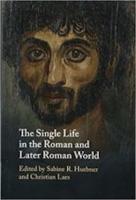
Cambridge (2019) h/b 425pp £95 (ISBN 9781108470179)
The fulfilling lifestyle of the single is a much vaunted phenomenon of our times—the individual (of either sex) living alone but happily and independently fulfilled, socially, sexually and financially. It is a perfectly reasonable question to ask whether similar or different choices existed in antiquity.
This book is the result of a conference held in Rome in 2015 which asked just that question. Nineteen essays on aspects of the question generated by that conference have been assembled, mainly authored by academics from Europe or North America. There is a 37 page bibliography and a useful Index of Sources, including papyri, ostraka and inscriptions.
The issue is bedevilled, as Laes admits in his opening essay, by definitional issues. What is a single? Someone who is unmarried, whether temporarily or permanently by choice or by circumstances; someone who lives alone (possibly accompanied by a group of slaves) or a hermit; or someone who is sexually continent either by choice or by force of circumstances? Is the definition of a single woman different from that of a single man?
The project is also bedevilled by the paucity of sources and is frequently dependent on inscriptions or papyri. These sources in turn do not always use the language providing the definitions in the same way as the researcher does—puella, for example, is used occasionally in a context which differs from its strict definition. It is also easier to isolate single women than single men. Accordingly there is a tendency for the essays to use the definitions which provide the most resonance from the material that is being examined.
The first two essays that follow (Huebner and Boozer) concentrate on Egyptian material; the next five (Broekart, Grubbs, Kiiskinen, Elina, Pyy and Petrova) on the Early Roman empire ; the next two (Martens and Funderburk) on singles in Judaism; the next six (Goessens, Cribiore, Vualanto, Nathan, Efthymiades and Cromwell) on the late empire; and the final three (Benkheira, De Groot and Manfredini) on more modern comparative episodes—Early Islam, 16th century Netherlands and 19th century Italy.
Some of the essays seek to draw conclusions from literary texts—Kiiskinen (Catullus and Cicero); Pyy (the Aeneid), Martens (the New Testament) and Nathan (Confessions of Augustine)—but they are not more persuasive than the essays which draw on archaeological material.
Space does not permit comments on each of the essays in greater detail. The overall impression, however, is that at least up to Constantine’s conversion to Christianity, marriage and procreation were the preferred lifestyle, although in all periods there were probably more singles (by whatever definition) than might have been expected. Single life and the perils of promiscuity were always more hazardous for women than men. For strict Jewish men sexual continence was at times prized, but mainly it would appear to avoid the pollution of the sex act. Martens argues that in Jesus’ teaching the promotion of marriage may have been because marriage provided the least objectionable excuse for a basically unclean act. He hints that it may have been easier to reconcile total abstinence with the need to procreate if the last judgment was thought to be close at hand. After Constantine, deliberate abstinence for women became more acceptable and families would include a committed virgin in their household to enhance their standing.
The essays establish, I believe, that nowhere in antiquity did a welcoming lifestyle for the single (such as we see today) develop. Single life did exist and was largely tolerated, but in such a range of forms and for such a range of reasons that it may well resist taxonomy.
At £95 this is quite an expensive book and will probably attract a relatively small readership, but that readership will find a lot to get its teeth into.
Roger Barnes
